EasyJet: Disruptive Technologies and Their Applications to Operations
VerifiedAdded on 2023/01/12
|8
|2269
|34
Report
AI Summary
This report analyzes the application of disruptive technologies, particularly biometric technology, within EasyJet's landside operations. It explores how these technologies can be implemented to avoid or better manage operational disruptions, enhancing customer experiences and improving operational quality. The report critically evaluates the integration of disruptive technologies, highlighting the benefits such as improved security, enhanced passenger experiences, and operational efficiency. It also discusses limitations, including the impact of weather, potential technical issues, and the high costs associated with implementation. The conclusion emphasizes the importance of pre-planning and analysis before adopting disruptive technologies to maximize benefits and mitigate risks, ensuring sustainable success in the aviation industry.
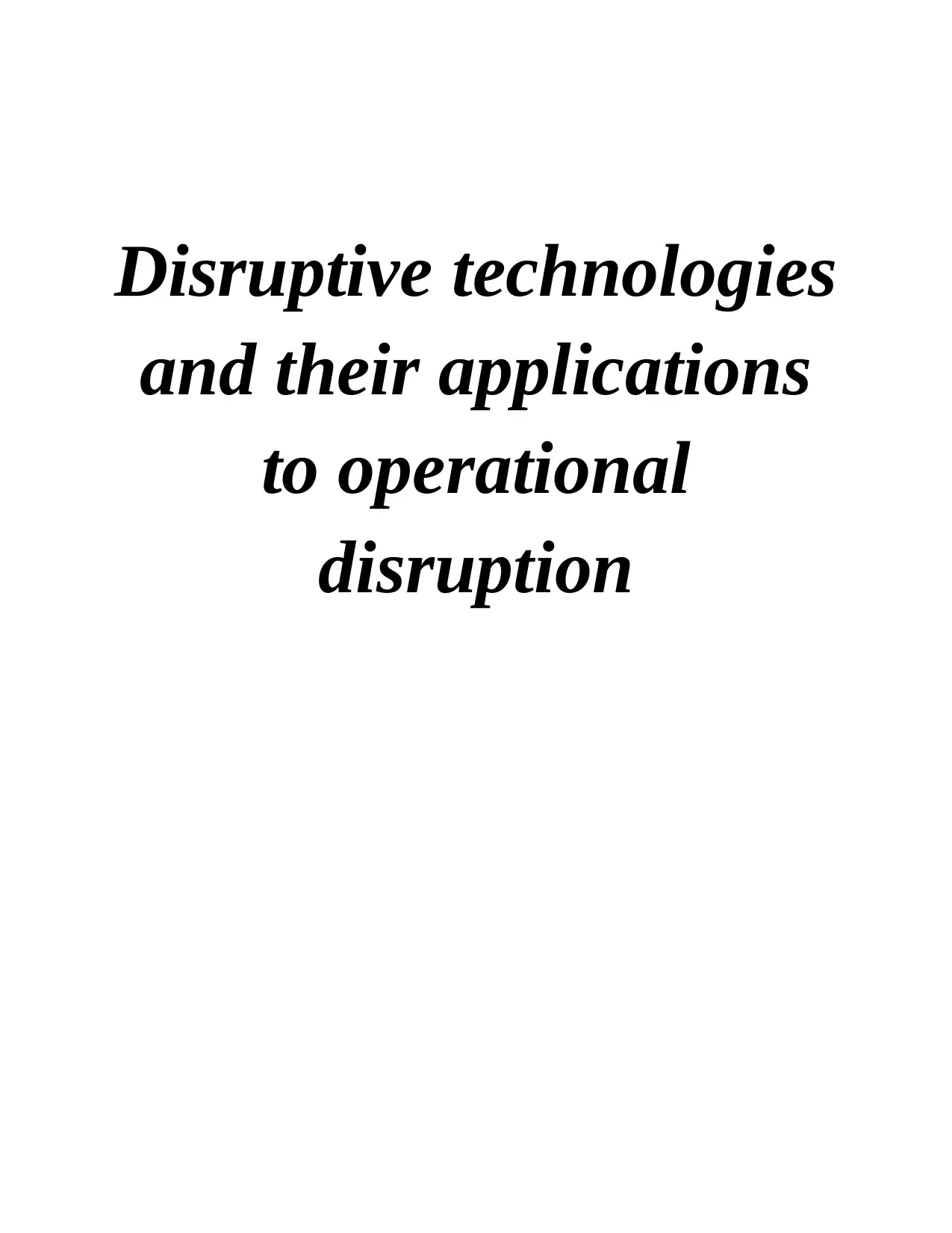
Disruptive technologies
and their applications
to operational
disruption
and their applications
to operational
disruption
Paraphrase This Document
Need a fresh take? Get an instant paraphrase of this document with our AI Paraphraser
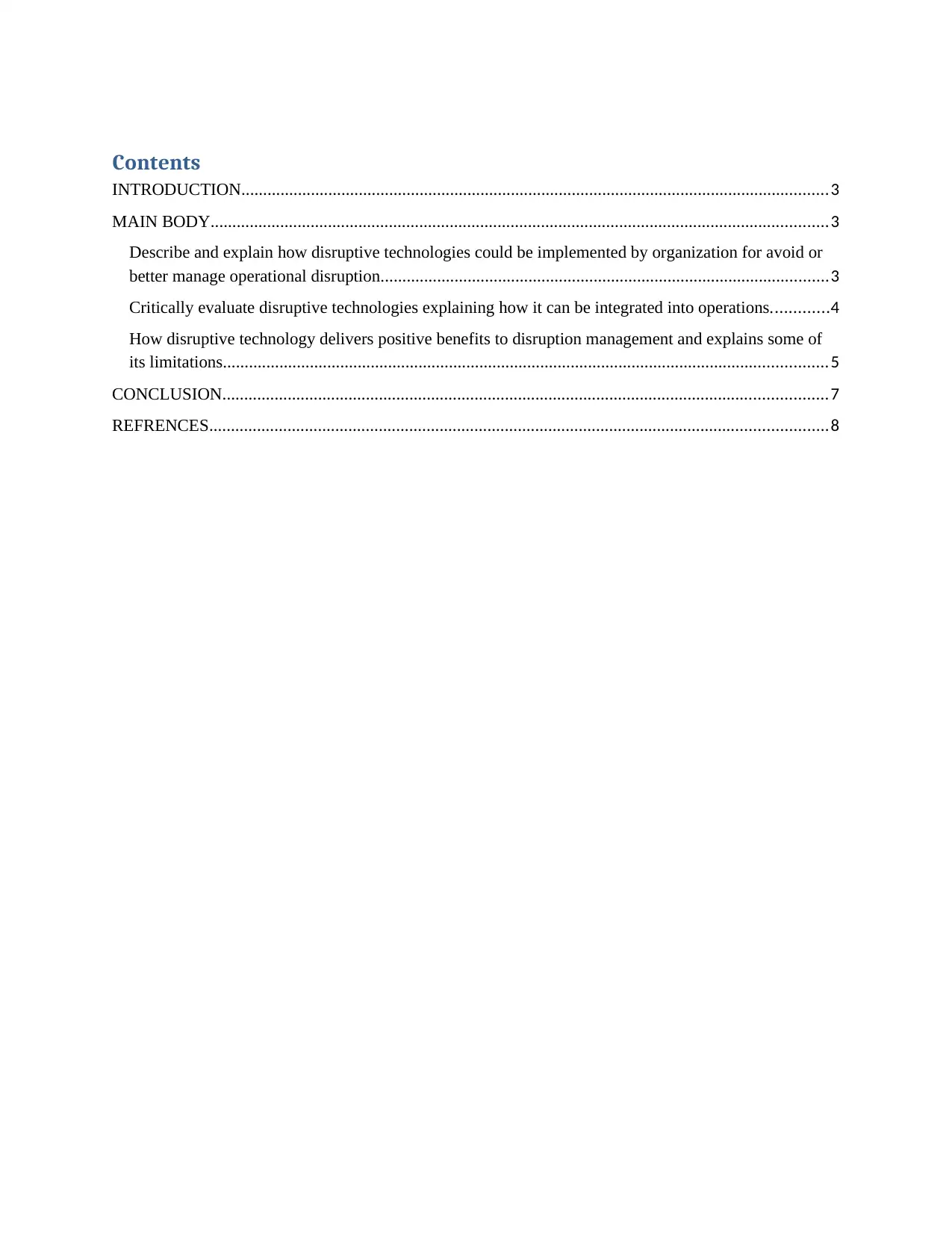
Contents
INTRODUCTION.......................................................................................................................................3
MAIN BODY..............................................................................................................................................3
Describe and explain how disruptive technologies could be implemented by organization for avoid or
better manage operational disruption.......................................................................................................3
Critically evaluate disruptive technologies explaining how it can be integrated into operations.............4
How disruptive technology delivers positive benefits to disruption management and explains some of
its limitations...........................................................................................................................................5
CONCLUSION...........................................................................................................................................7
REFRENCES..............................................................................................................................................8
INTRODUCTION.......................................................................................................................................3
MAIN BODY..............................................................................................................................................3
Describe and explain how disruptive technologies could be implemented by organization for avoid or
better manage operational disruption.......................................................................................................3
Critically evaluate disruptive technologies explaining how it can be integrated into operations.............4
How disruptive technology delivers positive benefits to disruption management and explains some of
its limitations...........................................................................................................................................5
CONCLUSION...........................................................................................................................................7
REFRENCES..............................................................................................................................................8
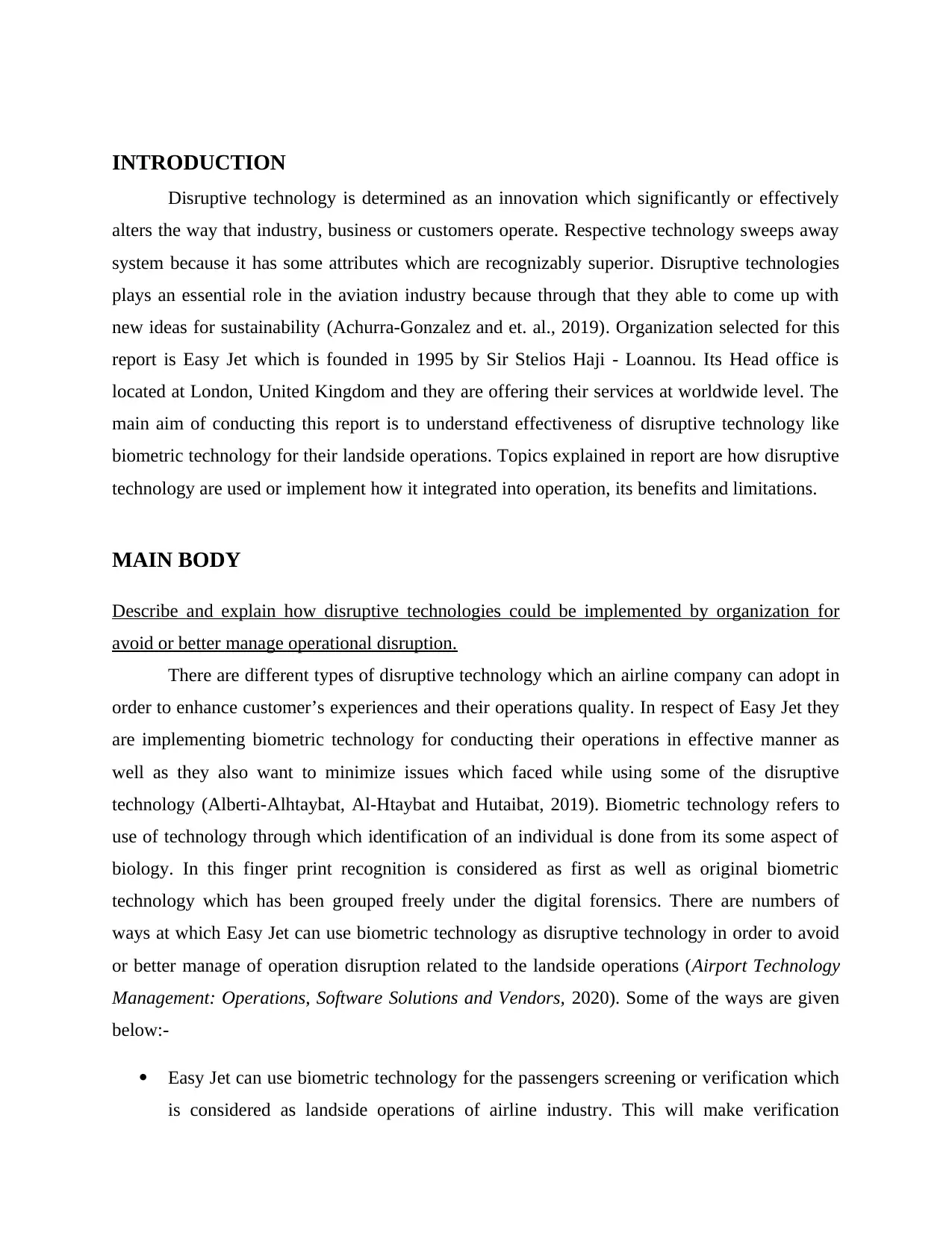
INTRODUCTION
Disruptive technology is determined as an innovation which significantly or effectively
alters the way that industry, business or customers operate. Respective technology sweeps away
system because it has some attributes which are recognizably superior. Disruptive technologies
plays an essential role in the aviation industry because through that they able to come up with
new ideas for sustainability (Achurra-Gonzalez and et. al., 2019). Organization selected for this
report is Easy Jet which is founded in 1995 by Sir Stelios Haji - Loannou. Its Head office is
located at London, United Kingdom and they are offering their services at worldwide level. The
main aim of conducting this report is to understand effectiveness of disruptive technology like
biometric technology for their landside operations. Topics explained in report are how disruptive
technology are used or implement how it integrated into operation, its benefits and limitations.
MAIN BODY
Describe and explain how disruptive technologies could be implemented by organization for
avoid or better manage operational disruption.
There are different types of disruptive technology which an airline company can adopt in
order to enhance customer’s experiences and their operations quality. In respect of Easy Jet they
are implementing biometric technology for conducting their operations in effective manner as
well as they also want to minimize issues which faced while using some of the disruptive
technology (Alberti-Alhtaybat, Al-Htaybat and Hutaibat, 2019). Biometric technology refers to
use of technology through which identification of an individual is done from its some aspect of
biology. In this finger print recognition is considered as first as well as original biometric
technology which has been grouped freely under the digital forensics. There are numbers of
ways at which Easy Jet can use biometric technology as disruptive technology in order to avoid
or better manage of operation disruption related to the landside operations (Airport Technology
Management: Operations, Software Solutions and Vendors, 2020). Some of the ways are given
below:-
Easy Jet can use biometric technology for the passengers screening or verification which
is considered as landside operations of airline industry. This will make verification
Disruptive technology is determined as an innovation which significantly or effectively
alters the way that industry, business or customers operate. Respective technology sweeps away
system because it has some attributes which are recognizably superior. Disruptive technologies
plays an essential role in the aviation industry because through that they able to come up with
new ideas for sustainability (Achurra-Gonzalez and et. al., 2019). Organization selected for this
report is Easy Jet which is founded in 1995 by Sir Stelios Haji - Loannou. Its Head office is
located at London, United Kingdom and they are offering their services at worldwide level. The
main aim of conducting this report is to understand effectiveness of disruptive technology like
biometric technology for their landside operations. Topics explained in report are how disruptive
technology are used or implement how it integrated into operation, its benefits and limitations.
MAIN BODY
Describe and explain how disruptive technologies could be implemented by organization for
avoid or better manage operational disruption.
There are different types of disruptive technology which an airline company can adopt in
order to enhance customer’s experiences and their operations quality. In respect of Easy Jet they
are implementing biometric technology for conducting their operations in effective manner as
well as they also want to minimize issues which faced while using some of the disruptive
technology (Alberti-Alhtaybat, Al-Htaybat and Hutaibat, 2019). Biometric technology refers to
use of technology through which identification of an individual is done from its some aspect of
biology. In this finger print recognition is considered as first as well as original biometric
technology which has been grouped freely under the digital forensics. There are numbers of
ways at which Easy Jet can use biometric technology as disruptive technology in order to avoid
or better manage of operation disruption related to the landside operations (Airport Technology
Management: Operations, Software Solutions and Vendors, 2020). Some of the ways are given
below:-
Easy Jet can use biometric technology for the passengers screening or verification which
is considered as landside operations of airline industry. This will make verification
⊘ This is a preview!⊘
Do you want full access?
Subscribe today to unlock all pages.

Trusted by 1+ million students worldwide
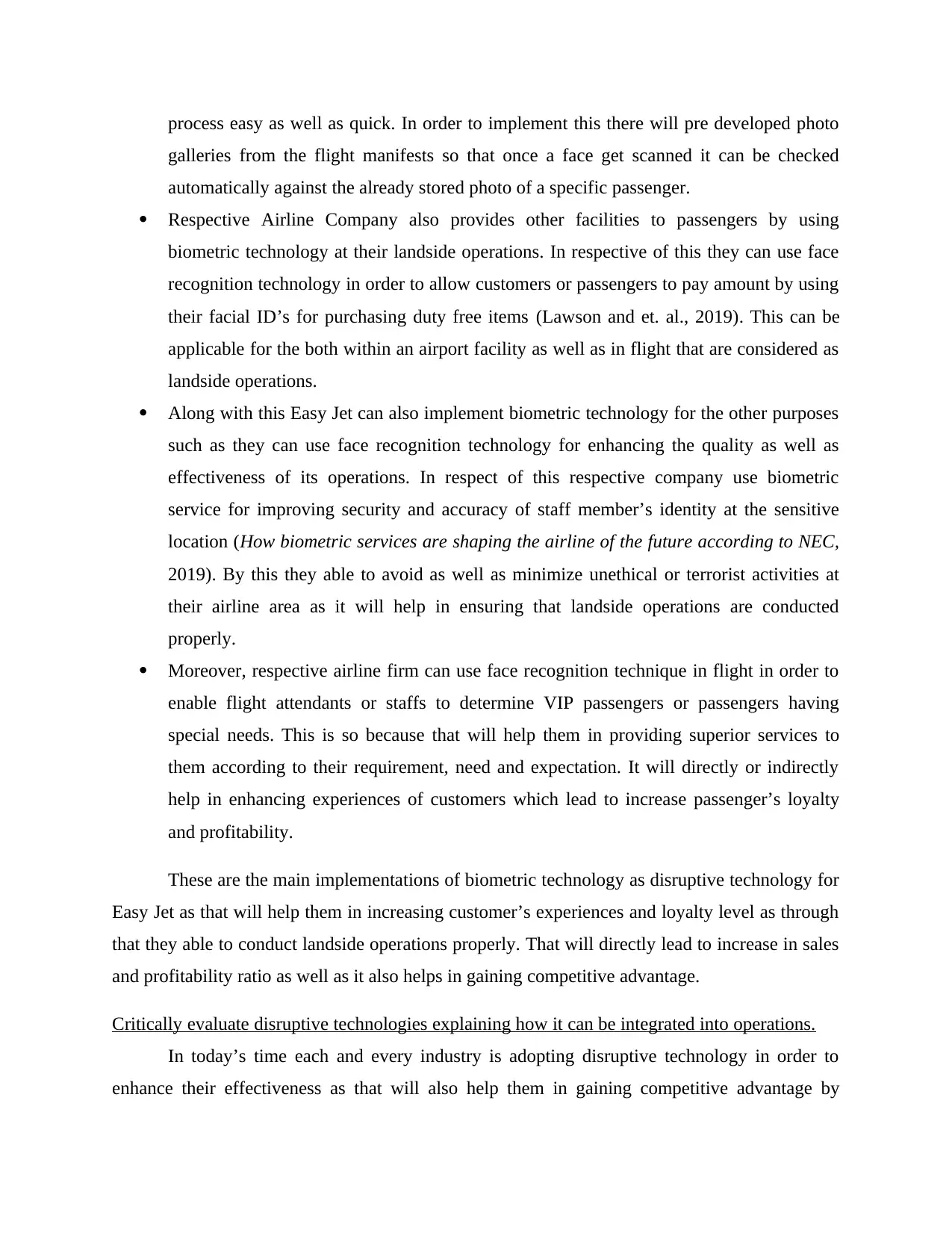
process easy as well as quick. In order to implement this there will pre developed photo
galleries from the flight manifests so that once a face get scanned it can be checked
automatically against the already stored photo of a specific passenger.
Respective Airline Company also provides other facilities to passengers by using
biometric technology at their landside operations. In respective of this they can use face
recognition technology in order to allow customers or passengers to pay amount by using
their facial ID’s for purchasing duty free items (Lawson and et. al., 2019). This can be
applicable for the both within an airport facility as well as in flight that are considered as
landside operations.
Along with this Easy Jet can also implement biometric technology for the other purposes
such as they can use face recognition technology for enhancing the quality as well as
effectiveness of its operations. In respect of this respective company use biometric
service for improving security and accuracy of staff member’s identity at the sensitive
location (How biometric services are shaping the airline of the future according to NEC,
2019). By this they able to avoid as well as minimize unethical or terrorist activities at
their airline area as it will help in ensuring that landside operations are conducted
properly.
Moreover, respective airline firm can use face recognition technique in flight in order to
enable flight attendants or staffs to determine VIP passengers or passengers having
special needs. This is so because that will help them in providing superior services to
them according to their requirement, need and expectation. It will directly or indirectly
help in enhancing experiences of customers which lead to increase passenger’s loyalty
and profitability.
These are the main implementations of biometric technology as disruptive technology for
Easy Jet as that will help them in increasing customer’s experiences and loyalty level as through
that they able to conduct landside operations properly. That will directly lead to increase in sales
and profitability ratio as well as it also helps in gaining competitive advantage.
Critically evaluate disruptive technologies explaining how it can be integrated into operations.
In today’s time each and every industry is adopting disruptive technology in order to
enhance their effectiveness as that will also help them in gaining competitive advantage by
galleries from the flight manifests so that once a face get scanned it can be checked
automatically against the already stored photo of a specific passenger.
Respective Airline Company also provides other facilities to passengers by using
biometric technology at their landside operations. In respective of this they can use face
recognition technology in order to allow customers or passengers to pay amount by using
their facial ID’s for purchasing duty free items (Lawson and et. al., 2019). This can be
applicable for the both within an airport facility as well as in flight that are considered as
landside operations.
Along with this Easy Jet can also implement biometric technology for the other purposes
such as they can use face recognition technology for enhancing the quality as well as
effectiveness of its operations. In respect of this respective company use biometric
service for improving security and accuracy of staff member’s identity at the sensitive
location (How biometric services are shaping the airline of the future according to NEC,
2019). By this they able to avoid as well as minimize unethical or terrorist activities at
their airline area as it will help in ensuring that landside operations are conducted
properly.
Moreover, respective airline firm can use face recognition technique in flight in order to
enable flight attendants or staffs to determine VIP passengers or passengers having
special needs. This is so because that will help them in providing superior services to
them according to their requirement, need and expectation. It will directly or indirectly
help in enhancing experiences of customers which lead to increase passenger’s loyalty
and profitability.
These are the main implementations of biometric technology as disruptive technology for
Easy Jet as that will help them in increasing customer’s experiences and loyalty level as through
that they able to conduct landside operations properly. That will directly lead to increase in sales
and profitability ratio as well as it also helps in gaining competitive advantage.
Critically evaluate disruptive technologies explaining how it can be integrated into operations.
In today’s time each and every industry is adopting disruptive technology in order to
enhance their effectiveness as that will also help them in gaining competitive advantage by
Paraphrase This Document
Need a fresh take? Get an instant paraphrase of this document with our AI Paraphraser
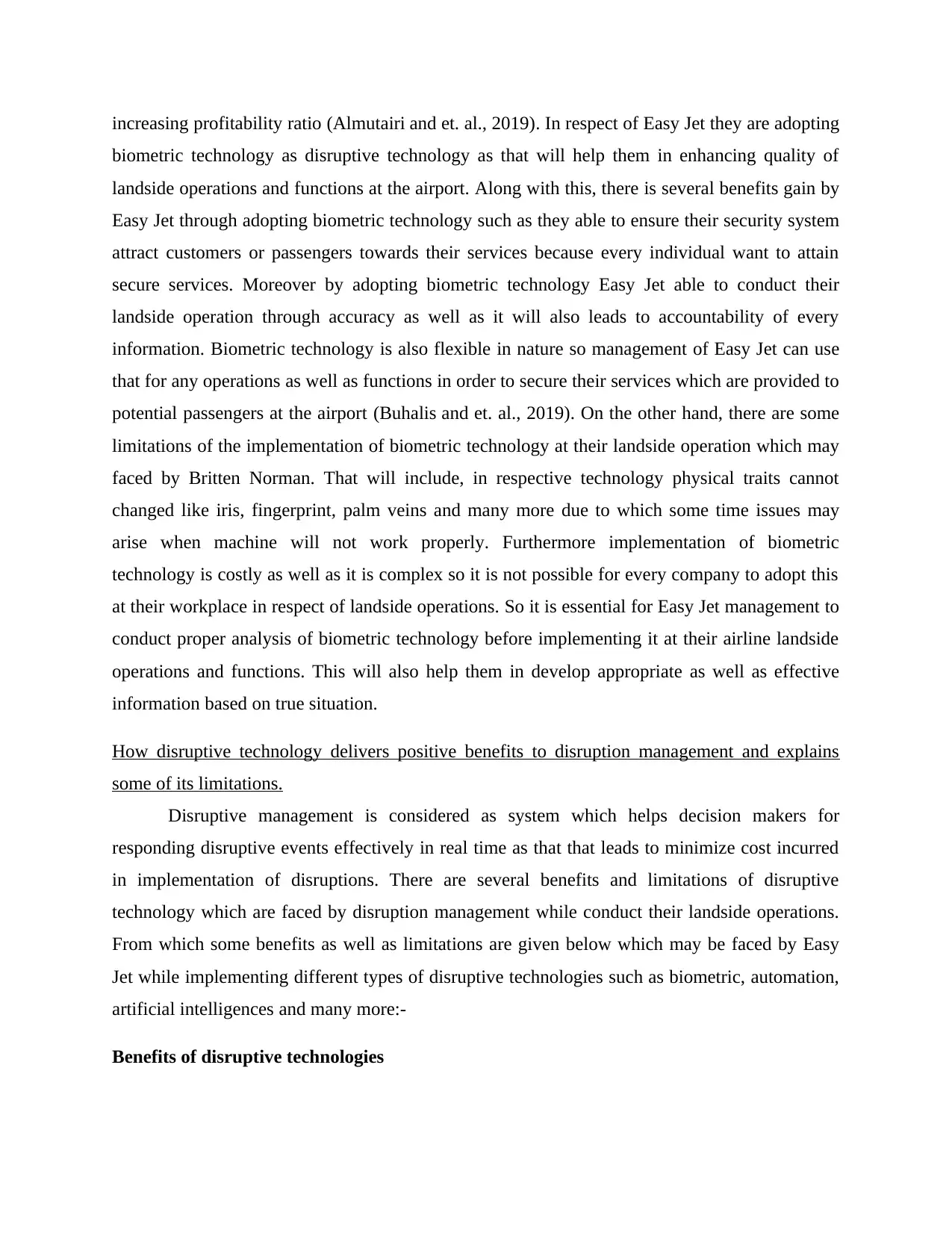
increasing profitability ratio (Almutairi and et. al., 2019). In respect of Easy Jet they are adopting
biometric technology as disruptive technology as that will help them in enhancing quality of
landside operations and functions at the airport. Along with this, there is several benefits gain by
Easy Jet through adopting biometric technology such as they able to ensure their security system
attract customers or passengers towards their services because every individual want to attain
secure services. Moreover by adopting biometric technology Easy Jet able to conduct their
landside operation through accuracy as well as it will also leads to accountability of every
information. Biometric technology is also flexible in nature so management of Easy Jet can use
that for any operations as well as functions in order to secure their services which are provided to
potential passengers at the airport (Buhalis and et. al., 2019). On the other hand, there are some
limitations of the implementation of biometric technology at their landside operation which may
faced by Britten Norman. That will include, in respective technology physical traits cannot
changed like iris, fingerprint, palm veins and many more due to which some time issues may
arise when machine will not work properly. Furthermore implementation of biometric
technology is costly as well as it is complex so it is not possible for every company to adopt this
at their workplace in respect of landside operations. So it is essential for Easy Jet management to
conduct proper analysis of biometric technology before implementing it at their airline landside
operations and functions. This will also help them in develop appropriate as well as effective
information based on true situation.
How disruptive technology delivers positive benefits to disruption management and explains
some of its limitations.
Disruptive management is considered as system which helps decision makers for
responding disruptive events effectively in real time as that that leads to minimize cost incurred
in implementation of disruptions. There are several benefits and limitations of disruptive
technology which are faced by disruption management while conduct their landside operations.
From which some benefits as well as limitations are given below which may be faced by Easy
Jet while implementing different types of disruptive technologies such as biometric, automation,
artificial intelligences and many more:-
Benefits of disruptive technologies
biometric technology as disruptive technology as that will help them in enhancing quality of
landside operations and functions at the airport. Along with this, there is several benefits gain by
Easy Jet through adopting biometric technology such as they able to ensure their security system
attract customers or passengers towards their services because every individual want to attain
secure services. Moreover by adopting biometric technology Easy Jet able to conduct their
landside operation through accuracy as well as it will also leads to accountability of every
information. Biometric technology is also flexible in nature so management of Easy Jet can use
that for any operations as well as functions in order to secure their services which are provided to
potential passengers at the airport (Buhalis and et. al., 2019). On the other hand, there are some
limitations of the implementation of biometric technology at their landside operation which may
faced by Britten Norman. That will include, in respective technology physical traits cannot
changed like iris, fingerprint, palm veins and many more due to which some time issues may
arise when machine will not work properly. Furthermore implementation of biometric
technology is costly as well as it is complex so it is not possible for every company to adopt this
at their workplace in respect of landside operations. So it is essential for Easy Jet management to
conduct proper analysis of biometric technology before implementing it at their airline landside
operations and functions. This will also help them in develop appropriate as well as effective
information based on true situation.
How disruptive technology delivers positive benefits to disruption management and explains
some of its limitations.
Disruptive management is considered as system which helps decision makers for
responding disruptive events effectively in real time as that that leads to minimize cost incurred
in implementation of disruptions. There are several benefits and limitations of disruptive
technology which are faced by disruption management while conduct their landside operations.
From which some benefits as well as limitations are given below which may be faced by Easy
Jet while implementing different types of disruptive technologies such as biometric, automation,
artificial intelligences and many more:-
Benefits of disruptive technologies
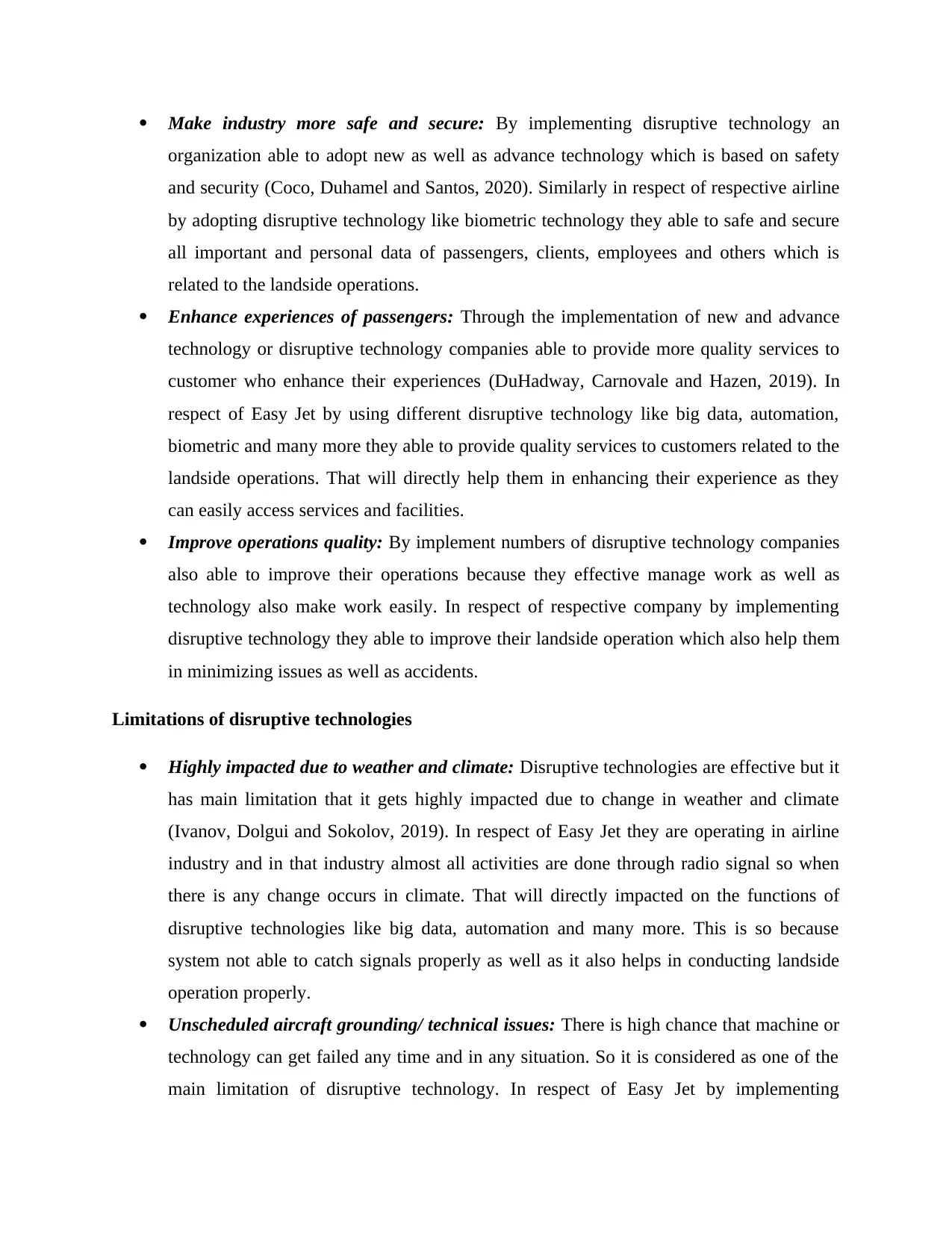
Make industry more safe and secure: By implementing disruptive technology an
organization able to adopt new as well as advance technology which is based on safety
and security (Coco, Duhamel and Santos, 2020). Similarly in respect of respective airline
by adopting disruptive technology like biometric technology they able to safe and secure
all important and personal data of passengers, clients, employees and others which is
related to the landside operations.
Enhance experiences of passengers: Through the implementation of new and advance
technology or disruptive technology companies able to provide more quality services to
customer who enhance their experiences (DuHadway, Carnovale and Hazen, 2019). In
respect of Easy Jet by using different disruptive technology like big data, automation,
biometric and many more they able to provide quality services to customers related to the
landside operations. That will directly help them in enhancing their experience as they
can easily access services and facilities.
Improve operations quality: By implement numbers of disruptive technology companies
also able to improve their operations because they effective manage work as well as
technology also make work easily. In respect of respective company by implementing
disruptive technology they able to improve their landside operation which also help them
in minimizing issues as well as accidents.
Limitations of disruptive technologies
Highly impacted due to weather and climate: Disruptive technologies are effective but it
has main limitation that it gets highly impacted due to change in weather and climate
(Ivanov, Dolgui and Sokolov, 2019). In respect of Easy Jet they are operating in airline
industry and in that industry almost all activities are done through radio signal so when
there is any change occurs in climate. That will directly impacted on the functions of
disruptive technologies like big data, automation and many more. This is so because
system not able to catch signals properly as well as it also helps in conducting landside
operation properly.
Unscheduled aircraft grounding/ technical issues: There is high chance that machine or
technology can get failed any time and in any situation. So it is considered as one of the
main limitation of disruptive technology. In respect of Easy Jet by implementing
organization able to adopt new as well as advance technology which is based on safety
and security (Coco, Duhamel and Santos, 2020). Similarly in respect of respective airline
by adopting disruptive technology like biometric technology they able to safe and secure
all important and personal data of passengers, clients, employees and others which is
related to the landside operations.
Enhance experiences of passengers: Through the implementation of new and advance
technology or disruptive technology companies able to provide more quality services to
customer who enhance their experiences (DuHadway, Carnovale and Hazen, 2019). In
respect of Easy Jet by using different disruptive technology like big data, automation,
biometric and many more they able to provide quality services to customers related to the
landside operations. That will directly help them in enhancing their experience as they
can easily access services and facilities.
Improve operations quality: By implement numbers of disruptive technology companies
also able to improve their operations because they effective manage work as well as
technology also make work easily. In respect of respective company by implementing
disruptive technology they able to improve their landside operation which also help them
in minimizing issues as well as accidents.
Limitations of disruptive technologies
Highly impacted due to weather and climate: Disruptive technologies are effective but it
has main limitation that it gets highly impacted due to change in weather and climate
(Ivanov, Dolgui and Sokolov, 2019). In respect of Easy Jet they are operating in airline
industry and in that industry almost all activities are done through radio signal so when
there is any change occurs in climate. That will directly impacted on the functions of
disruptive technologies like big data, automation and many more. This is so because
system not able to catch signals properly as well as it also helps in conducting landside
operation properly.
Unscheduled aircraft grounding/ technical issues: There is high chance that machine or
technology can get failed any time and in any situation. So it is considered as one of the
main limitation of disruptive technology. In respect of Easy Jet by implementing
⊘ This is a preview!⊘
Do you want full access?
Subscribe today to unlock all pages.

Trusted by 1+ million students worldwide
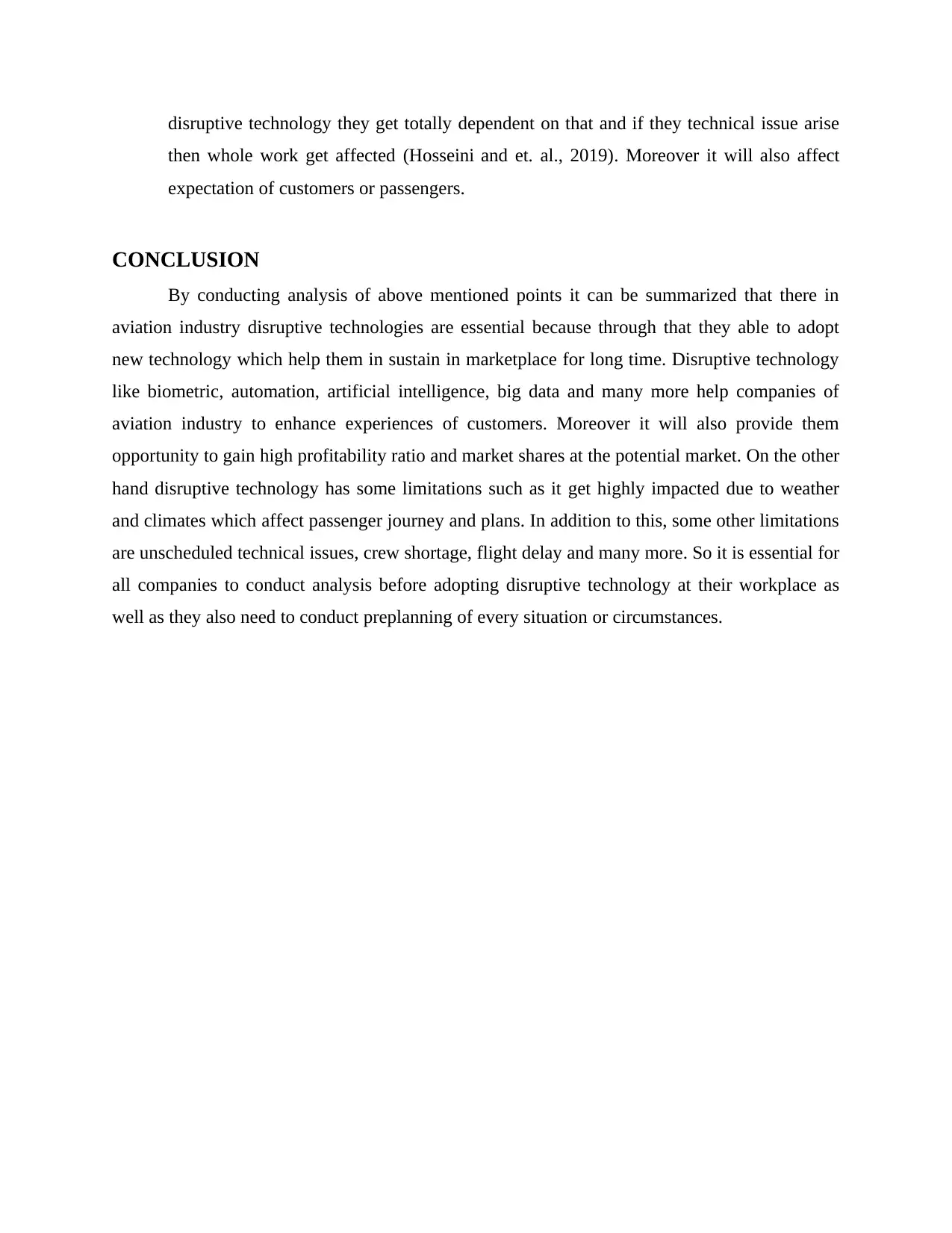
disruptive technology they get totally dependent on that and if they technical issue arise
then whole work get affected (Hosseini and et. al., 2019). Moreover it will also affect
expectation of customers or passengers.
CONCLUSION
By conducting analysis of above mentioned points it can be summarized that there in
aviation industry disruptive technologies are essential because through that they able to adopt
new technology which help them in sustain in marketplace for long time. Disruptive technology
like biometric, automation, artificial intelligence, big data and many more help companies of
aviation industry to enhance experiences of customers. Moreover it will also provide them
opportunity to gain high profitability ratio and market shares at the potential market. On the other
hand disruptive technology has some limitations such as it get highly impacted due to weather
and climates which affect passenger journey and plans. In addition to this, some other limitations
are unscheduled technical issues, crew shortage, flight delay and many more. So it is essential for
all companies to conduct analysis before adopting disruptive technology at their workplace as
well as they also need to conduct preplanning of every situation or circumstances.
then whole work get affected (Hosseini and et. al., 2019). Moreover it will also affect
expectation of customers or passengers.
CONCLUSION
By conducting analysis of above mentioned points it can be summarized that there in
aviation industry disruptive technologies are essential because through that they able to adopt
new technology which help them in sustain in marketplace for long time. Disruptive technology
like biometric, automation, artificial intelligence, big data and many more help companies of
aviation industry to enhance experiences of customers. Moreover it will also provide them
opportunity to gain high profitability ratio and market shares at the potential market. On the other
hand disruptive technology has some limitations such as it get highly impacted due to weather
and climates which affect passenger journey and plans. In addition to this, some other limitations
are unscheduled technical issues, crew shortage, flight delay and many more. So it is essential for
all companies to conduct analysis before adopting disruptive technology at their workplace as
well as they also need to conduct preplanning of every situation or circumstances.
Paraphrase This Document
Need a fresh take? Get an instant paraphrase of this document with our AI Paraphraser
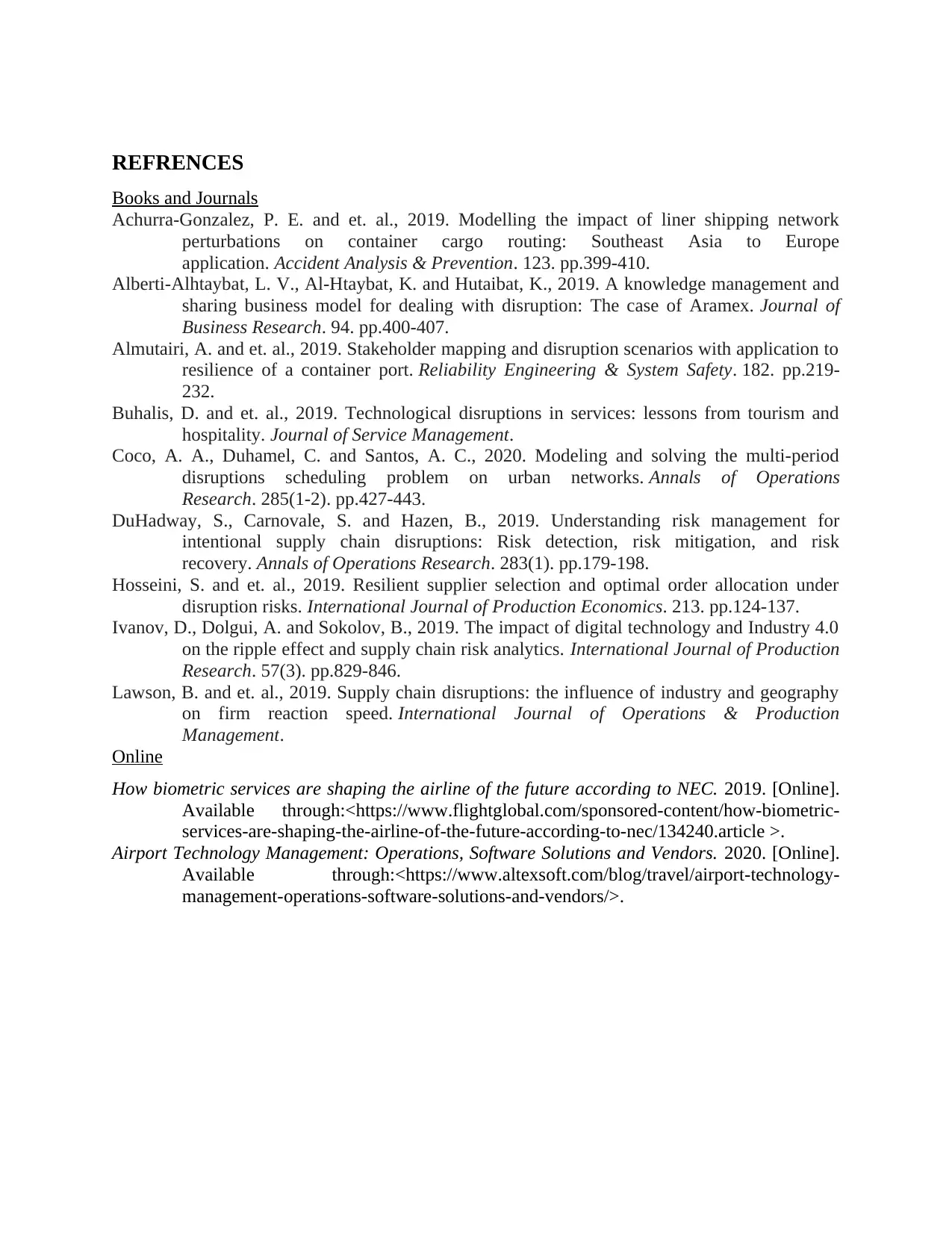
REFRENCES
Books and Journals
Achurra-Gonzalez, P. E. and et. al., 2019. Modelling the impact of liner shipping network
perturbations on container cargo routing: Southeast Asia to Europe
application. Accident Analysis & Prevention. 123. pp.399-410.
Alberti-Alhtaybat, L. V., Al-Htaybat, K. and Hutaibat, K., 2019. A knowledge management and
sharing business model for dealing with disruption: The case of Aramex. Journal of
Business Research. 94. pp.400-407.
Almutairi, A. and et. al., 2019. Stakeholder mapping and disruption scenarios with application to
resilience of a container port. Reliability Engineering & System Safety. 182. pp.219-
232.
Buhalis, D. and et. al., 2019. Technological disruptions in services: lessons from tourism and
hospitality. Journal of Service Management.
Coco, A. A., Duhamel, C. and Santos, A. C., 2020. Modeling and solving the multi-period
disruptions scheduling problem on urban networks. Annals of Operations
Research. 285(1-2). pp.427-443.
DuHadway, S., Carnovale, S. and Hazen, B., 2019. Understanding risk management for
intentional supply chain disruptions: Risk detection, risk mitigation, and risk
recovery. Annals of Operations Research. 283(1). pp.179-198.
Hosseini, S. and et. al., 2019. Resilient supplier selection and optimal order allocation under
disruption risks. International Journal of Production Economics. 213. pp.124-137.
Ivanov, D., Dolgui, A. and Sokolov, B., 2019. The impact of digital technology and Industry 4.0
on the ripple effect and supply chain risk analytics. International Journal of Production
Research. 57(3). pp.829-846.
Lawson, B. and et. al., 2019. Supply chain disruptions: the influence of industry and geography
on firm reaction speed. International Journal of Operations & Production
Management.
Online
How biometric services are shaping the airline of the future according to NEC. 2019. [Online].
Available through:<https://www.flightglobal.com/sponsored-content/how-biometric-
services-are-shaping-the-airline-of-the-future-according-to-nec/134240.article >.
Airport Technology Management: Operations, Software Solutions and Vendors. 2020. [Online].
Available through:<https://www.altexsoft.com/blog/travel/airport-technology-
management-operations-software-solutions-and-vendors/>.
Books and Journals
Achurra-Gonzalez, P. E. and et. al., 2019. Modelling the impact of liner shipping network
perturbations on container cargo routing: Southeast Asia to Europe
application. Accident Analysis & Prevention. 123. pp.399-410.
Alberti-Alhtaybat, L. V., Al-Htaybat, K. and Hutaibat, K., 2019. A knowledge management and
sharing business model for dealing with disruption: The case of Aramex. Journal of
Business Research. 94. pp.400-407.
Almutairi, A. and et. al., 2019. Stakeholder mapping and disruption scenarios with application to
resilience of a container port. Reliability Engineering & System Safety. 182. pp.219-
232.
Buhalis, D. and et. al., 2019. Technological disruptions in services: lessons from tourism and
hospitality. Journal of Service Management.
Coco, A. A., Duhamel, C. and Santos, A. C., 2020. Modeling and solving the multi-period
disruptions scheduling problem on urban networks. Annals of Operations
Research. 285(1-2). pp.427-443.
DuHadway, S., Carnovale, S. and Hazen, B., 2019. Understanding risk management for
intentional supply chain disruptions: Risk detection, risk mitigation, and risk
recovery. Annals of Operations Research. 283(1). pp.179-198.
Hosseini, S. and et. al., 2019. Resilient supplier selection and optimal order allocation under
disruption risks. International Journal of Production Economics. 213. pp.124-137.
Ivanov, D., Dolgui, A. and Sokolov, B., 2019. The impact of digital technology and Industry 4.0
on the ripple effect and supply chain risk analytics. International Journal of Production
Research. 57(3). pp.829-846.
Lawson, B. and et. al., 2019. Supply chain disruptions: the influence of industry and geography
on firm reaction speed. International Journal of Operations & Production
Management.
Online
How biometric services are shaping the airline of the future according to NEC. 2019. [Online].
Available through:<https://www.flightglobal.com/sponsored-content/how-biometric-
services-are-shaping-the-airline-of-the-future-according-to-nec/134240.article >.
Airport Technology Management: Operations, Software Solutions and Vendors. 2020. [Online].
Available through:<https://www.altexsoft.com/blog/travel/airport-technology-
management-operations-software-solutions-and-vendors/>.
1 out of 8
Related Documents
Your All-in-One AI-Powered Toolkit for Academic Success.
+13062052269
info@desklib.com
Available 24*7 on WhatsApp / Email
![[object Object]](/_next/static/media/star-bottom.7253800d.svg)
Unlock your academic potential
Copyright © 2020–2025 A2Z Services. All Rights Reserved. Developed and managed by ZUCOL.





